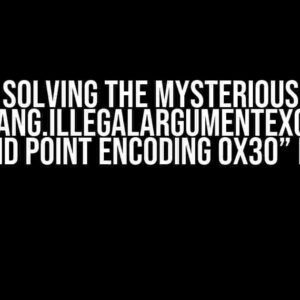Have you ever tried to delete the last element in an array of objects, only to be met with an error message that left you scratching your head? Don’t worry, you’re not alone! In this article, we’ll dive into the common reasons behind this issue and provide you with clear, step-by-step solutions to get you back on track.
The Typical Scenario
Let’s say you have an array of objects, and you want to delete the last element using the splice() method. You write the code, run it, and… BOOM! An error message appears, leaving you wondering what went wrong.
const arr = [
{ id: 1, name: 'John' },
{ id: 2, name: 'Jane' },
{ id: 3, name: 'Bob' }
];
arr.splice(arr.length - 1, 1);
The Error Message
The error message you receive might look something like this:
Cannot read property 'length' of undefined
Or maybe it’s something like:
TypeError: Cannot delete property '3' of [object Array]
Whatever the message, it’s clear that something is amiss. But fear not, dear developer! We’re about to uncover the reasons behind this issue and provide you with solutions to overcome it.
Reason 1: Array Index Out of Bounds
One common reason for this error is that you’re trying to access an array index that doesn’t exist. When you use arr.length - 1 to delete the last element, you’re assuming that the array has at least one element. But what if the array is empty?
const arr = []; arr.splice(arr.length - 1, 1); // Error: Cannot read property 'length' of undefined
In this case, arr.length - 1 would evaluate to -1, which is an invalid array index. To avoid this, make sure to check if the array is not empty before attempting to delete the last element:
if (arr.length > 0) {
arr.splice(arr.length - 1, 1);
}
Reason 2: Incorrect Splice Syntax
Another reason for the error might be that you’re using the splice() method incorrectly. The syntax for splice() is:
arr.splice(start, deleteCount, item1, item2, ...)
Where:
startis the index at which to start deleting elements.deleteCountis the number of elements to delete.item1, item2, ...are the elements to add to the array (optional).
If you’re not careful, you might end up with the wrong syntax, which can lead to errors. Make sure to double-check your code and ensure that you’re using the correct syntax:
arr.splice(arr.length - 1, 1); // Correct syntax
Reason 3: Using splice() on a null or undefined Array
It’s possible that the array you’re trying to manipulate is null or undefined. This can happen when you’re working with dynamic data or API responses that might return empty or null values.
const arr = null; arr.splice(arr.length - 1, 1); // Error: Cannot read property 'length' of null
To avoid this, make sure to check if the array is not null or undefined before attempting to delete the last element:
if (arr !== null && arr !== undefined) {
arr.splice(arr.length - 1, 1);
}
Solution: Using the Filter() Method
Instead of using splice(), you can use the filter() method to delete the last element in an array of objects. This approach is more elegant and avoids the potential pitfalls of splice().
const arr = [
{ id: 1, name: 'John' },
{ id: 2, name: 'Jane' },
{ id: 3, name: 'Bob' }
];
arr = arr.filter((item, index) => index !== arr.length - 1);
This code uses the filter() method to create a new array with all elements except the last one. The callback function takes two arguments: item and index. We use the index argument to check if we’re at the last element, and if so, we exclude it from the new array.
Solution: Using the Pop() Method
Another solution is to use the pop() method, which removes the last element from an array and returns it. This approach is simple and efficient:
const arr = [
{ id: 1, name: 'John' },
{ id: 2, name: 'Jane' },
{ id: 3, name: 'Bob' }
];
arr.pop();
The pop() method is a straightforward way to delete the last element in an array of objects. It’s less error-prone than splice() and doesn’t require you to worry about indexing or syntax.
Conclusion
Deleting the last element in an array of objects can be a tricky business, but with the right approach, you can avoid common pitfalls and errors. By understanding the reasons behind the issue and using the solutions provided, you’ll be able to confidently manipulate your arrays and objects.
Remember to:
- Check if the array is not empty before attempting to delete the last element.
- Use the correct syntax for the
splice()method. - Ensure the array is not null or undefined before manipulating it.
- Consider using the
filter()orpop()methods as alternatives tosplice().
With these tips and techniques, you’ll be well on your way to becoming an array manipulation master!
| Method | Description |
|---|---|
splice() |
Deletes a specified number of elements from an array, starting from a specified index. |
filter() |
Creates a new array with all elements that pass a test implemented by a provided function. |
pop() |
Removes the last element from an array and returns it. |
Now, go forth and conquer those arrays!
Frequently Asked Question
Stuck on deleting the last element in an array of objects? You’re not alone! Here are some commonly asked questions and answers to get you out of this sticky situation.
Why do I get an error when deleting the last element in an array of objects?
This error usually occurs because the array becomes empty after deleting the last element, and you’re trying to access an index that no longer exists. It’s like trying to find a book on an empty shelf!
Is it possible to delete the last element without getting an error?
Yes, it is! You can use the `pop()` method, which removes the last element from an array and returns it. This way, you avoid trying to access an index that doesn’t exist. Simple yet effective!
What if I want to delete a specific element, not just the last one?
In that case, you can use the `splice()` method, which removes elements from an array starting from a specified index. Just be careful not to try to access an index that’s out of bounds! Use `filter()` or `findIndex()` to locate the element you want to delete.
How do I avoid errors when working with arrays of objects in general?
To avoid errors, always check if the array is empty before trying to access or delete elements. You can also use methods like `every()` or `some()` to ensure the array contains elements before performing operations. And, of course, always validate your data and indices!
What if I’m using a library or framework that doesn’t support these methods?
If you’re working with a specific library or framework, check its documentation for array manipulation methods. You might need to use workarounds or polyfills to achieve the desired result. And, if all else fails, consider using a more modern or versatile library!



